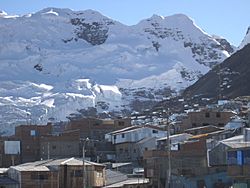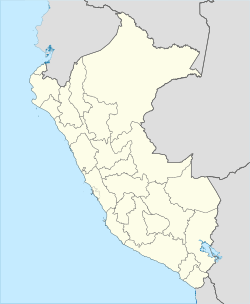La Rinconada, Peru facts for kids
Quick facts for kids
La Rinconada
|
||
|---|---|---|

View of the town
|
||
|
||
| Country | ||
| Region | Puno | |
| Province | San Antonio de Putina | |
| District | Ananea | |
| Elevation | 5,100 m (16,700 ft) | |
| Population
(2024)
|
||
| • Total | 29,678 | |
| Demonym(s) | Rinconero(a) | |
La Rinconada is a unique town located high in the Peruvian Andes mountains. It is famous for being the highest permanent settlement in the world. This town sits at an amazing height of about 5,100 meters (16,732 feet) above sea level, which is even higher than many mountain peaks!
The town grew from a small camp for gold miners. Between 2001 and 2009, its population grew quickly because the price of gold went up a lot. Some estimates suggest it reached 30,000 people, though official counts were lower.
Contents
Where is La Rinconada?
La Rinconada is part of the Ananea District in the San Antonio de Putina Province. This area is in the Puno Region of Peru. It is located in a very high mountain zone called the Janca region. Its extreme height makes it a truly special place on Earth.
What's in a Name?
The name "La Rinconada" comes from the Spanish language. It means "The Cornered One."
Geography and Landscape
Mountain Setting
The town of La Rinconada is nestled on the side of Mount Ananea. It also sits at the base of a glacier known as Auchita, which is also called "La Bella Durmiente" (The Sleeping Beauty). The town itself ranges in height from about 4,900 meters (16,076 feet) to 5,100 meters (16,732 feet) above sea level. The very center of the town is around 5,000 meters (16,404 feet) high.
Some miners who have found success in La Rinconada choose to live in a nearby city called Juliaca. Juliaca is lower down, at 3,825 meters (12,549 feet) above sea level, and has more city services.
Climate and Weather
Because La Rinconada is so high in the Andes, it has an alpine tundra climate. This means it's very cold, and trees cannot grow there. The average temperature is only about 1.3°C (34.3°F) throughout the year.
Even though it's close to the equator, the weather in La Rinconada feels more like the west coast of Greenland. Summers are rainy, and winters are dry. Days are cool to cold, and nights are freezing all year round. Snowfall is also very common. The town gets about 707 millimeters (27.8 inches) of rain and snow each year.
| Climate data for La Rinconada | |||||||||||||
|---|---|---|---|---|---|---|---|---|---|---|---|---|---|
| Month | Jan | Feb | Mar | Apr | May | Jun | Jul | Aug | Sep | Oct | Nov | Dec | Year |
| Mean daily maximum °C (°F) | 8.3 (46.9) |
7.7 (45.9) |
8.0 (46.4) |
8.6 (47.5) |
8.5 (47.3) |
8.2 (46.8) |
8.2 (46.8) |
9.6 (49.3) |
9.6 (49.3) |
11.0 (51.8) |
10.3 (50.5) |
8.7 (47.7) |
8.9 (48.0) |
| Daily mean °C (°F) | 2.6 (36.7) |
2.5 (36.5) |
2.4 (36.3) |
1.7 (35.1) |
0.5 (32.9) |
−1.7 (28.9) |
−1.5 (29.3) |
−0.4 (31.3) |
1.3 (34.3) |
2.5 (36.5) |
2.4 (36.3) |
2.7 (36.9) |
1.3 (34.3) |
| Mean daily minimum °C (°F) | −3.1 (26.4) |
−2.6 (27.3) |
−3.2 (26.2) |
−5.1 (22.8) |
−7.5 (18.5) |
−11.6 (11.1) |
−11.2 (11.8) |
−10.3 (13.5) |
−7.0 (19.4) |
−5.9 (21.4) |
−5.5 (22.1) |
−3.3 (26.1) |
−6.4 (20.6) |
| Average precipitation mm (inches) | 135 (5.3) |
113 (4.4) |
106 (4.2) |
50 (2.0) |
19 (0.7) |
7 (0.3) |
6 (0.2) |
15 (0.6) |
34 (1.3) |
51 (2.0) |
67 (2.6) |
104 (4.1) |
707 (27.7) |
| Source: Climate-data.org | |||||||||||||
Population Growth
The population of La Rinconada has changed a lot over the years. In 1981, the Ananea District, where La Rinconada is, had only 2,707 people.
When gold prices went up a lot between 2001 and 2009, many people moved to La Rinconada hoping to find gold. Some reports said the population reached 30,000 by 2009. However, official government counts from 2007 and 2017 showed lower numbers for the district. In 2017, the census recorded about 12,615 people in the Ananea District.
Economy and Gold Mining
The main way people make a living in La Rinconada is through gold mines. Many of these are small, independent mines.
The Cachorreo System
Miners at the Corporación Ananea gold mine use a special system called cachorreo. Here's how it works:
- Miners work for 30 days without getting paid.
- Then, for one day, they are allowed to mine for themselves.
- On this special day, miners can take as much ore (rock that might contain gold) as they can carry on their shoulders.
- Whether the ore contains any gold or not is a matter of luck! Sometimes, they find valuable pieces of gold.
Women are not allowed to work directly inside the mines. However, pallaqueras are women who work outside the mines. They search through the discarded rocks and dirt, hoping to find any valuable bits of gold that were missed.
Transportation
The closest major airport for La Rinconada is Inca Manco Cápac International Airport. It is located in the city of Juliaca.
See also
 In Spanish: La Rinconada (Perú) para niños
In Spanish: La Rinconada (Perú) para niños



